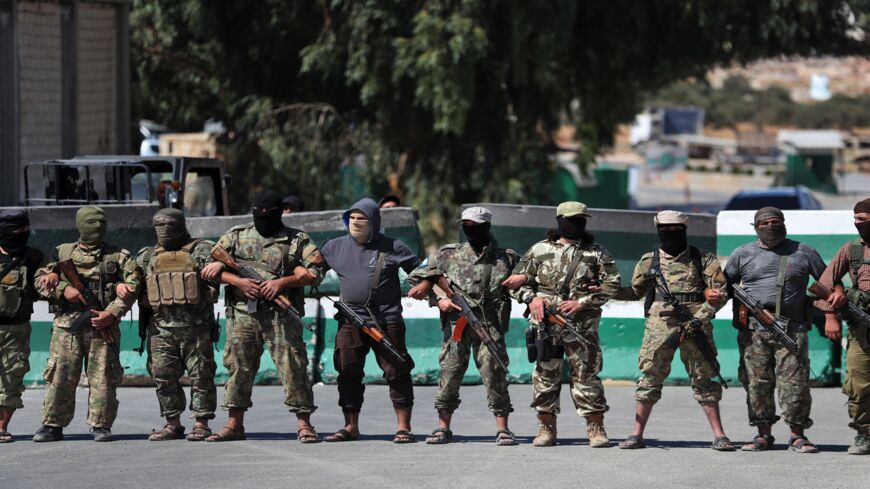
Jihadis of former al-Qaeda affiliate Hayat Tahrir al-Sham block demonstrators from approaching the Bab al-Hawa crossing between Turkey and Syria’s northwestern Idlib province during a protest against the Syrian regime and its ally Russia on Sept. 20, 2019. – OMAR HAJ KADOUR/AFP via Getty Images
by Manish Rai 18 August 2023
There is a growing perception among the people that these are the last days of the Islamic State and the United States and its allies war on terror has almost ended in Syria. But still, in one corner of Syria, Jihadists enjoy a safe haven and are even thriving. Hayat Tahrir al-Sham (HTS), formerly known as al-Nusra Front, once an al-Qaeda branch in Syria has totally consolidated its hold on Idlib province and literally operates as the de-facto state in the tiny statelet it created. HTS subscribes to the Salafist school of thought which is the same as al-Qaeda’s. The group imposed strict Islamic rule in areas it controls and is accused of grave human rights abuses including torture, forced disappearance, rape and other sexual violence, and killing in detention. Also, Hayat Tahrir al-Sham hosts many foreign fighters including Arabs, Turks, Chechens, Uzbeks, and from China’s Xinjiang province. Moreover, the group’s attitude toward heterodox minorities like the Druze, Christians, and Alawites never changed. It will be right to say that HTS in Idlib province acts as a facilitator and provides an ecosystem for the jihadist forces to operate and regroup. But unfortunately, the policymakers in the West remain solely focused on defeating ISIS and have ignored HTS and its acolytes.
Hayat Tahrir al-Sham in the past tried to showcase through various mergers with other groups that it has ended its affiliation with al-Qaeda but definitely, these mergers did not indicate an ideological split with al-Qaeda. But it was indeed part of a strategy to increase the group’s appeal within Syria. On the ground in Syria, various smaller outfits proclaiming loyalty to al-Qaeda, including some HTS defectors. They came together and formed a group called Hurras al-Din (HD) also known as al-Qaeda in Syria. It was officially announced in late February 2018, although it existed sometime before that. It’s the official branch of al-Qaeda in Syria and operates primarily in Idlib province. It will be erroneous to presume that Hurras al-Din somehow exists in isolation from HTS. Given HTS’ dominance of the Idlib Hurras al-Din cannot exist in isolation, nor can it undertake operations without HTS’ knowledge. In fact, Hurras al-Din previously had multiple meetings with HTS. These meetings were in regard to a dispute over weapons in HTS custody that Hurras al-Din claims belong to it, and HTS suggestions to form a larger military council. Currently, as well Hurras al-Din still maintains a constant line of communication with HTS. Previously in some credible media reports, there have been claims that certain frontline points manned by members of Hurras al-Din are supervised by HTS which is allegedly responsible for providing them with the logistics. Another major concern is that at present, there are thousands of fighters who after being defeated on other fronts by Syrian government forces were allowed to move to Idlib. These fighters include those associated with al-Qaeda and the Islamic State while a significant number of them are prone to be radical Islamists. These fighters based in Idlib are seen as a very attractive source of recruitment by Jihadist outfits.
The controversial HTS leader Abu Mohammed al-Jolani is listed as a specially designated global terrorist by the United States. And a reward of $10 million for information leading to his arrest is still in place. Most of the leaders of ISIS also find refuge in Idlib. And it is evident from the fact that many of its senior and mid-level leaders were killed in the special operations of either the US or Turkey in Idlib including its founder leader Abu Bakr al-Baghdadi in October 2019. Tahrir al-Sham claims to be cracking down on both al-Qaeda and Islamic State cells in its territory. But this claim seems to be a hollow one in fact it seems remnants of ISIS are now regrouping in Idlib. As per the US Commission on International Religious Freedom report released in November 2022. HTS remains a potent source of Salafi-Jihadism that restricts the religious freedom of non-conforming Sunni Muslims and threatens the property, safety, and existence of religious minority groups such as Alawites, Christians, and Druze.
Idlib under Hayat Tahrir al-Sham remains a ticking time bomb that arguably poses a greater long-term threat to the region and Syria’s stability. Now after one phase of the war on global jihad is over, another phase should start with the sole focus to finish off HTS. The West’s own ability to tackle and contain Jihadist elements in northwest Syria is rather limited. This is because the West is excluded from the de-escalation framework in the region agreed between Turkey and Russia and is thus barred, among others, from using the airspace to launch precision strikes against the group. But still, if the United States and its allies have to coordinate with Turkey and Russia in this regard it should be done without any hesitation. Because Tahrir al-Sham and its jihadi extremist network still pose one of the greatest long-term challenges for the US and other Western countries which are trying to eradicate extremists from Syria. Amid the confusion of Syria’s kaleidoscopic and multi-sided conflict, one thing remains certain that Hayat Tahrir al-Sham must be isolated, marginalized, and defeated before a stable peace can emerge in Syria.
(Author is a columnist for Middle-East and Af-Pak region and Editor of the geo-political news agency ViewsAround can be reached at manishraiva@gmail.com)
